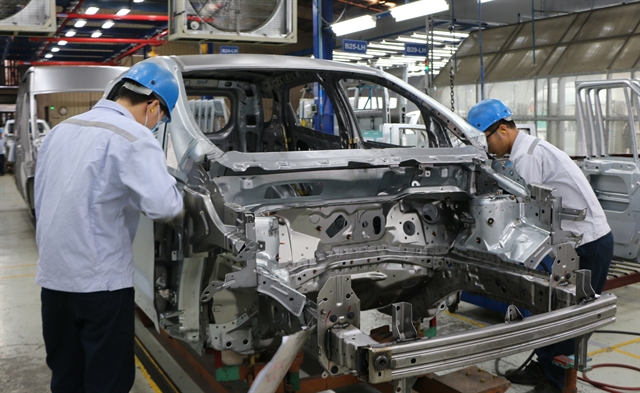 Economy
Economy

 |
| Workers assemble cars at Ford Hải Dương. Regulations on the automobile localisation ratio will soon be revoked to be in line with the development and change of technological processes of automobile production and assembly. — VNS Photo Đoàn Tùng |
HÀ NỘI — Regulations on the automobile localisation ratio will be abolished on October 10, 2022 after having been in force for almost 20 years.
The Ministry of Science and Technology last week enacted Circular No 11/2022/TT-BKHCN to rescind the regulations that calculate the automobile localisation ratio, including Decision No 28/2004, Decision No 05/ 2005 and Circular 05/2012. The new circular will take effect from October 1 this year.
Under current regulations, Việt Nam calculates the automobile localisation ratio by clusters of components produced in the country. Meanwhile, other countries calculate this as a percentage of domestic production value.
This makes it difficult for businesses to enjoy the preferential import tax rate of zero percent if the automobile localisation ratio within the bloc, as with ASEAN, is 40 per cent.
Regarding the discrete level of imported auto parts, components must come in clusters, accompanied by many different details.
Việt Nam's automobile industry remains a fledgling one after more than 30 years since the country opened its door to foreign investment.
The current average localisation ratio of passenger cars with up to nine seats is as low as 7-10 per cent, according to data released by Deputy Minister of Industry and Trade Đỗ Thắng Hải last August. The Government target is 30-40 per cent by 2020, 40-45 per cent by 2025 and 50-55 per cent by 2030.
The Ministry of Industry and Trade (MoIT) reports that the current localisation ratio is now 40-50 per cent for trucks, and 55 per cent for buses. Therefore, the current regulations related to methods of determining the localisation rate were no longer relevant.
Benefits
According to the Vietnam Association of Mechanical Industry (VAMI), the regulations related to the automobile localisation ratio should be abolished to encourage competitiveness among domestic enterprises.
Automotive experts said the abolition of these regulations is in line with the development and change of technological processes of automobile production and assembly in the country and the world to ensure transparency. The abolition will also help meet international standards.
The removal of those regulations would also help improve the investment climate and allow domestic automobile manufacturers to maintain production in competition with completely-built-up (CBU) cars imported from ASEAN countries with a tax rate of zero per cent from 2018.
Car expert Nguyễn Minh Đông said that it was difficult to produce high-quality automobiles with the current localisation ratio regulations. Some important parts of the cars were low quality, while others were highly valued. The adjustment to the auto localisation rate calculations will encourage manufacturers to improve their product quality with the most advanced technology.
Moreover, the features and auto parts have become increasingly innovative and modern, accounting for a large proportion of the overall value of the vehicle. For instance, car body frames are more complex than those for buses.
According to the MoIT, the localisation rate of passenger cars in Việt Nam is still quite low due to the slow development of auto parts and accessories suppliers, in terms of both quantity and quality. Only a few domestic suppliers can get involved in the supply chains of automobile manufacturers in Việt Nam.
According to the MoIT, the average output growth of the auto industry is much lower than that of the whole industry.
Domestic enterprises have been left behind in the race for high-quality auto parts and accessories due to their low speed of technological innovation. Many auto parts suppliers still have little capability and production technology to get involved in the value chains of the domestic automotive industry.
Over the past 10 years, Việt Nam has signed a series of free trade agreements (FTAs), such as the ASEAN Trade in Goods Agreement, the Comprehensive and Progressive Agreement for Trans-Pacific Partnership, and the EU–Việt Nam Free Trade Agreement.
These agreements require member states to commit to the removal of tariff barriers for imported cars and auto parts. — VNS




